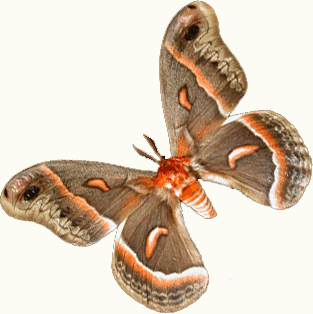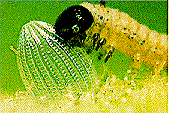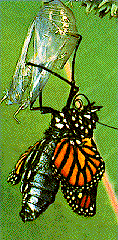This introduction
is an excerpt from the Illinois Butterflies and Moths poster information
published by the Illinois Department of Natural Resources.
Butterflies and
moths (Lepidoptera), like other insects, have three main body
parts — head, thorax, and abdomen. They also have three pairs of
legs and a pair of antennae. Most have two pairs of wings that are covered
with tiny scales. The arrangement of the scales is responsible for the
diverse patterns on the wings of the various species. A few species
are wingless, including, in Illinois, the female bagworm
moth (Thyridopteryx ephemaeriformis) and the female white-marked
gypsy moth (Orgyia leucostigma).
Anatomy of the
Adult
 The
mouth parts of adults are modified into a tube-like proboscis for taking
in liquids such as nector or sap. The proboscis is coiled at the front
of the head when not in use. Some species, such as the common Illinois
moths cecropia (Hyalophora cecropia, pictured here) and luna
(Actias luna), do not feed as adults.
The
mouth parts of adults are modified into a tube-like proboscis for taking
in liquids such as nector or sap. The proboscis is coiled at the front
of the head when not in use. Some species, such as the common Illinois
moths cecropia (Hyalophora cecropia, pictured here) and luna
(Actias luna), do not feed as adults.
Anatomy of the
Larva
The cylindrical larva (caterpillar) is soft-bodied. It has a hardened
head with chewing mouthparts (mandibles), well-developed maxillary palpi
(finger-like structures) for food handling, and spinnerets (tubes from
the silk glands) for releasing silk.
The thorax has one pair of legs on each of its three segments. Spiracles
for breathing are found on the thorax (one pair) and the abdomen (one
pair on each segment). Abdominal segments three through ten have prolegs
(fleshy legs without joints). The prolegs often have little hooks (crochets)
that let the caterpillar cling to leaves and stems of plants. The body
may also have spines, hairs, or bumps. Colors range from camouflage
to bright warning. Some species, such as swallowtail larvae, give off
a disagreeable odor.
Is It a Butterfly
or a Moth?
A key characteristic in telling whether a given individual is a butterfly
or a moth is its antennae. Butterflies usually have threadlike, knob-tipped
antennae. Moth antennae have many shapes, including a feather shape
(such as in the image above), and never have knobbed tips. Generally,
moths' bodies are fatter and more feathered that bodies of butterflies.
Life Cycle
Butterflies and
moths undergo a complete metamorphosis (change in form) of four stages:
 Egg:
Eggs are laid singly or in clusters on or near a host plant.
Egg:
Eggs are laid singly or in clusters on or near a host plant.
Larva:
Larvae of some species feed on one plant, while many other larvae
feed on many plants. The larvae grow and molt (shed their exoskeleton).
 Pupa:
The larva of many species of moths and some species of butterflies
spin a cocoon in which to pupate (transform into the adult stage),
usually on or near their host plant. Other species pupate in a sheltered
area such as leaf litter or in the soil.
Pupa:
The larva of many species of moths and some species of butterflies
spin a cocoon in which to pupate (transform into the adult stage),
usually on or near their host plant. Other species pupate in a sheltered
area such as leaf litter or in the soil.
Image: Adult
emerging from a chrysalis.
Adult:
The pupal skin splits apart, and the newly formed, soft adult emerges.
Most adults live only about two weeks, during which they mate and
lay eggs. Some species overwinter in one of their stages, and adult
monarchs (Danaus plexippus) and painted lady (Cynthia
cardui) migrate to Mexico in the fall.
Related Activities:
Symmetry in Art (html)
(pdf)
Butterfly Poster (html)
(pdf)

